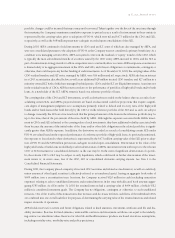American Express 2003 Annual Report Download - page 60
Download and view the complete annual report
Please find page 60 of the 2003 American Express annual report below. You can navigate through the pages in the report by either clicking on the pages listed below, or by using the keyword search tool below to find specific information within the annual report.
(p.58_axp_ financial review)
Committed Bank Credit Facilities
The Company maintained committed bank credit facilities with 60 large financial institutions totaling $10.85 billion
(including $1.29 billion at the Parent Company) at December 31, 2003. These facilities expire as follows (billions): 2004,
$5.4; 2005, $2.3; 2006, $2.2 and 2007, $1.0. The availability of the credit lines is subject to the Company’s compliance with
certain financial covenants, including the maintenance by the Company of consolidated tangible net worth of at least $7.75
billion, the maintenance by Credco of a 1.25 ratio of combined earnings and fixed charges to fixed charges, and the com-
pliance by Centurion Bank with applicable regulatory capital adequacy guidelines. At December 31, 2003, the Company’s
consolidated tangible net worth was approximately $12.4 billion, Credco’s ratio of combined earnings and fixed charges to
fixed charges was 1.46 and Centurion Bank exceeded the Federal Deposit Insurance Corporation’s “well capitalized” regu-
latory capital adequacy guidelines.
Committed bank credit facilities do not contain material adverse change clauses, which may preclude borrowing under the
credit facilities. The facilities may not be terminated should there be a change in the Company’s credit rating.
Contingent Liquidity Planning
TRS has developed a contingent funding plan that enables it to meet its daily funding obligations when access to unsecured
funds in the debt capital markets is impaired or unavailable. This plan is designed to ensure that the Company and all of
its main operating entities could continuously maintain normal business operations for at least a 12-month period in which
its access to unsecured funds is interrupted. The contingent funding plan includes access to diverse sources of alternative
funding, including but not limited to its liquidity investment portfolio, committed bank lines, intercompany borrowings,
sale of consumer loans and cardmember receivables through its existing securitization programs and sale of other eligible
receivables, such as corporate and small business receivables and international cardmember loans and receivables, through
enhanced securitization programs. In addition, the Company maintains substantial flexibility to reduce its operating cash
requirements, such as through its share repurchase program, and the delay or deferment of certain operating expenses.
The funding sources that would be relied upon depend on the exact nature of such a hypothetical liquidity crisis; nonethe-
less, TRS’ liquidity sources are designed with the goal of ensuring there is sufficient cash on hand to fund business opera-
tions over a 12-month period regardless of whether the liquidity crisis was caused by an external, industry or Company
specific event. The contingent funding plan also addresses operating flexibilities in quickly making these funding sources
available to meet all financial obligations. The simulated liquidity crisis is defined as a sudden and unexpected event that
impairs access to or makes unavailable funding in the unsecured debt markets. It does not address asset quality deteriora-
tion. Asset quality deterioration, if it were to occur, would be expected to unfold over an extended time period and should
allow management sufficient time to take appropriate corrective actions to mitigate further asset quality deterioration as it
becomes more visible. TRS estimates that, under a worst case liquidity crisis scenario, it has in excess of $25 billion in alter-
nate funding sources available to cover cash needs over the first 60 days after a liquidity crisis has occurred.
Contingent Securitization Capacity
A key source in the Company’s contingent funding plan is asset securitization. Management expects that $10 billion of addi-
tional consumer loans, cardmember receivables and small business loans could be sold to existing securitization trusts. In
order to further enhance its flexibility, the Company is seeking to add the capabilities to sell other assets from the loan and
cardmember receivables portfolios. The primary goal of adding this additional securitization capacity is to further enhance
the Company’s flexibility in accessing diverse funding sources on a contingency basis.
























